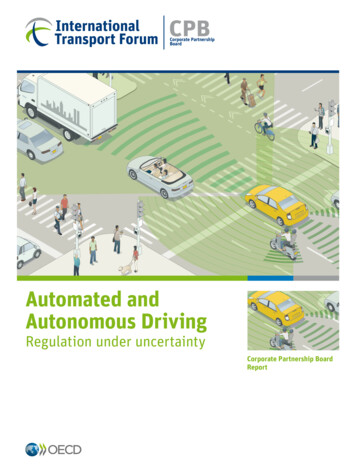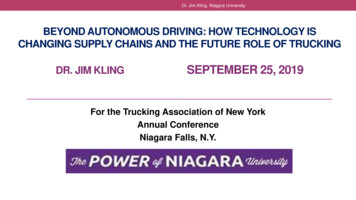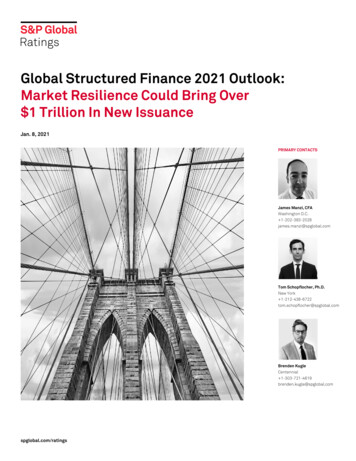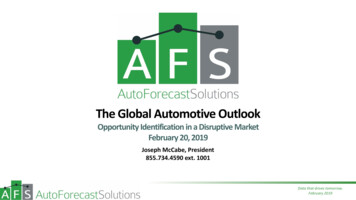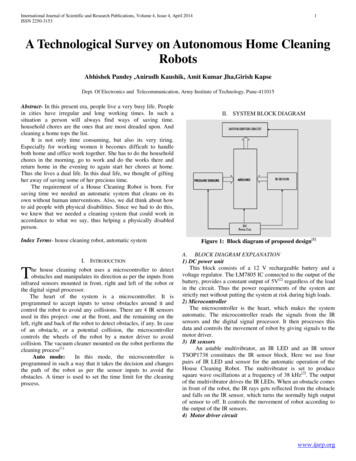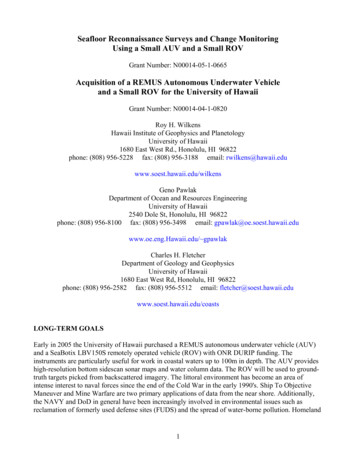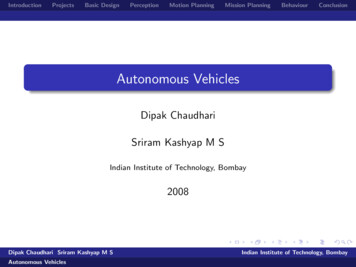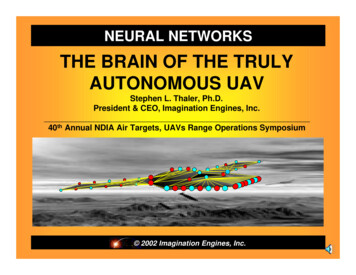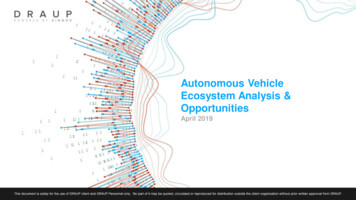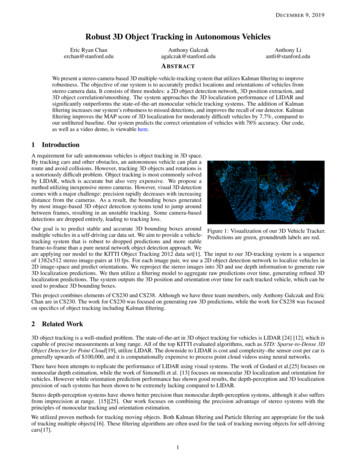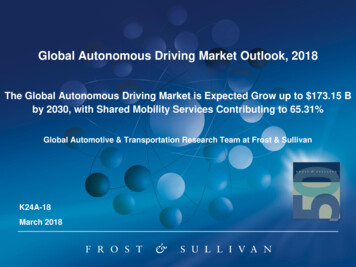
Transcription
Global Autonomous Driving Market Outlook, 2018The Global Autonomous Driving Market is Expected Grow up to 173.15 Bby 2030, with Shared Mobility Services Contributing to 65.31%Global Automotive & Transportation Research Team at Frost & SullivanK24A-18March 2018
ContentsSectionExecutive SummarySlide Number7 2017 Key Highlights8 Leading Players in terms of AD Patents Filed in 201710 Sensors Currently Used Across Applications11 Next Generations of Sensor Fusion12 Future Approach in Hardware and Software toward L5 Automation13 Level 3 Automated Vehicles—What could be new?14 2018 Top 5 Predictions15Research Scope and Segmentation16 Research Scope17 Vehicle Segmentation18 Market Definition—Rise of Automation19 Key Questions this Study will Answer20Impact of Autonomous Vehicles Driving Development of Vital Facets inBusiness and TechnologyK24A-18212
Contents (continued)SectionSlide Number Transformational Impact of Automation on the Industry22 Impact on the Development of Next-Generation Depth Sensing23 Impact on Ownership and User-ship Structures24 Impact of Autonomous Driving on Future Vehicle Design25 Impact of Investments on Technology Development26Major Market and Technology Trends in Automated Driving—2018 Top Trends Driving the Autonomous Driving Market—2018Market Trends272829 1. Autonomous Shared Mobility Solutions30 Case Study—Waymo31 2. Collective Intelligence for Fleet Management32 Case Study—BestMile33 3. Cyber Security of Autonomous Cars34 Case Study—Karamba Security35K24A-183
Contents (continued)SectionTechnology TrendsSlide Number36 1. Convergence of Artificial Intelligence and Automated Driving37 Case Study—Mobileye38 2. Domain Controllers39 Case Study—Audi zFAS (zentrale Fahrerassistenzsteuergerät)40 3. Driver Monitoring System41 Case Study—General Motors’ Driver Attention System42Automated Vehicle—Timeline and Major OEM and Supplier Activities43 Feature Roadmap—Autonomous Driving44 Major OEM Outlook—1: Global45 Major OEM Outlook—2: Global46 Autonomous Shared Mobility—Competition Landscape47 Technology Enablers and Major Suppliers48 Region-wise Estimation of AD Unit Shipments—Market Leaders49K24A-184
Contents (continued)SectionSlide Number Region-wise Estimation of AD Unit Shipments—Market Followers50 Total Market Size Autonomous Vehicles (Ownership)51 Automated Driving—Shared Mobility: Taxi, By Rides52 Automated Driving—Shared Mobility: Shuttles, By Rides53Key Start-ups and their Capabilities54 Frost & Sullivan's Key Criteria to Shortlist Companies55 Capabilities of Shortlisted Start-ups—ADAS Sensors56 Capabilities of Shortlisted Start-ups—Computer Vision Software57 Capabilities of Shortlisted Start-ups—Other Systems58Regional Market Trends and Analysis—201859 European Automated Market—Overview60 North American Automated Market—Overview61 APAC (China and Japan) Automated Market—Overview62Opportunity AnalysisK24A-18635
Contents (continued)SectionSlide Number Transformation in Autonomous Driving Ecosystem—201864 Growth Opportunity—Investments and Partnerships From OEMs/TSPs65 Strategic Imperatives for Success and Growth66Key Conclusions and Big Predictions for 201767 The Last Word—Three Big Predictions68 Legal Disclaimer69Appendix List of ExhibitsThe Frost & Sullivan StoryK24A-187071756
Executive SummaryReturn to contentsK24A-187
2017 Key HighlightsLaunch of level 3 (L3) automation, digitization of in-vehicle consoles, and improvements in hardware/softwaretesting and simulation capabilities using AI are key trends in the autonomous driving (AD) ecosystem in 2017.What F&S Predicted For 2017What Happened?Launch of the first L3 CarAudi is the world’s first OEM to have unveiled a car with L3 capabilities – the 2018A8 flagship launched in mid-2017 has all the necessary systems for hands-offhighway driving. It is also the first car to feature a long-range LiDAR at the front. TheL3 feature, currently not activated, is expected to be enabled by the OTA this year.2Compute power enhancementThe next generation of super computers enabling deep learning AI for objectdetection, classification and decision-making was introduced by Nvidia, Renesas,NXP, and Intel among others, and was tested by several of the top OEMs.3Strong growth expected in ADdeployment in shared mobility (taxi)platformsTop OEMs continued working toward having an autonomous vehicle shared mobilityportfolio along with improving driver assistance features on their legacy productlines. Besides this, businesses around data-as-a-service are also being explored.Improvement in Depth SensingSeveral start-ups and technology providers with capabilities in cost-effective depthsensing solutions best suited for AD emerged in 2017. The new generation of costeffective LiDARs, far IR cameras, and combination sensors were also showcased.5Multiple approaches for ADdevelopmentThe industry concurred that controlling automated vehicles with classical computeralgorithms with if/then rules is enormously challenging, but not completelyimpossible. This prompted several OEMs and technology suppliers to invest timeand money in researching more on AI to be the decision-making engines.6Electric vehicles/hybrids will bepreferred over traditional IC enginesfor autonomous and connecteddrivingLearning that electric vehicles are becoming competitive in terms of costeffectiveness, maintenance, and charging infrastructure when compared to gaspowered vehicles, OEMs have been investing heavily and have also began testingall-electric/hybrid powertrains equipped with AD features.14Source: Frost & SullivanK24A-188
2018–2019 Top-of-Mind Issues for Senior ManagementUnearthing the various monetization capabilities of AD beyond passenger vehicle sales is the key for tappinginto the vast potential of the technology.AD Market Outlook: Senior Management Top-of-Mind Issues, Global, 2018–2019Alternate business streamsfor automated mobilitysolutions5Consolidation of suppliercapabilities43Sensor suite competencypricepoints21Chinese tech invasion inSilicon Valley0Investment in ArtificialIntelligence (AI)Rising relevance of multiweather testing ofautonomous capabilitiesProliferation of electronicsand Big DataMobility partnershipsNote: Data collected over 2016-2017 interviews and discussions with Senior Managers to CEOlevel executives of passenger vehicle OEMs and tier-I suppliers in North America, Europe, AsiaPacific, China, India, Latin America, and other regionsK24A-18Scale: 0 means limited focus, 5 stands for top focusSource: Frost & Sullivan9
Leading Players in terms of AD Patents Filed in 2017Out of the top 10 patent holders, 6 are German companies with Bosch leading the tally with 958 patentsfiled until 2017.AD Market Outlook: Autonomous Driving Patent Race, Global, Until 2017958No. of 80370362343339338Company 52% of the patents registered globally for AD are from German companies. Connectivity technology, AI, and human-machine interface are the main areas of probable AD related patent litigation in the nextthree years. OEMs generally have not used patents as a revenue-generator, but as they invest more in developing their own technology theycould recoup this investment through licensing patents. Although Apple is currently not in the top 10 in terms of patents filed, it recently patented an autonomous navigation system, whichwould be dynamic and independent of any data received from any devices external to the vehicle, and any navigation data storedlocally to the vehicle prior to any monitoring of navigation.DisruptorK24A-18OEMSupplierSource: Cologne Institute for Economic Research - Based on the identified and analyzed 5,839patents related to autonomous driving, as of August2017; Frost & SullivanSource:10
Sensors Currently Used Across ApplicationsMost ADAS solutions currently in use employ stereo/mono camera and LRR-based sensor fusion as it is themost preferred by many OEMs due to its simplicity and high cost benefits.Long-Range Radar/ ForwardCamera/ LiDARACC, AEB Pedestrian DetectionForward CameraLevel 2 and 3 Automated DrivingFeatures, Lane KeepingFORWARD CAMERA: HFOV 45 ,Resolution: 640x480/ 1280x780Tracking Features: Vision TargetLRR: HFOV 30 , Range: 150mTracking Features: Point TargetForwardCamera/LiDARRoad Sign And BoardDetection, Level 3 and 4Automated Driving FeaturesLiDAR: HFOV 85 110 , VFOV: 15 Range: 100mTracking Features: Edge TargetGPSSONARLocalized VehiclePositioning/Lane CenteringStationary Obstacle Detection,Vacant Spot DetectionShort-Range Radars/Surround View CameraContextualized Pedestrian/Cyclist/Moving ObjectDetectionShort/Medium RangeRadarsBlind Spot Detection/ RearCross Traffic AlertSRR: HFOV 20 (near) 18 (far), Range: 60m (near)Tracking Features: Point TargetK24A-18Rear Camera/ SONARRear- AEB, Park AssistSVC: HFOV 45 Resolution: 640x480Tracking Features: Vision TargetSource: Frost & Sullivan11
Next Generations of Sensor FusionHighly automated and fully autonomous cars to have up to six radars and nine camera modules.AD Market Outlook: Transformation in Industry Approach in Hardware and Software, Global, 2012–2025 and beyondLevel 1Level 3Level 2Level 5Level 4Sensor – L1#Sensor -L2#Sensor – L3#Sensor – L4#Sensor – rasound8-10RADAR (LRR)1RADAR(LRR)1RADAR (LRR)2RADAR (LRR)22SRR2RADAR (SRR)4RADAR (SRR)4RADAR(LRR)2-41Camera (LR)22/3RADAR(SRR)Camera2-4Camera (Sur)4Camera(Stereo/Trifocal)4Camera/Short- rangeLiDARRADAR(SRR)42/31Camera (Sur)Camera (LR)Camera (Stereo)1Camera (Stereo)1Camera(Sur)4µboloLIDAR1µbolo12Dead reckoning1LIDAR2/4Camera(Stereo)Total 24-26Dead reckoning1µbolo1/2Total 2528LIDAR4Deadreckoning1Total 2832Total 6-8Lateral orLongitudinalAssistanceTotal 17Observation ofEnvironmentAwareness for Take OverNo Driver InteractionNo Driver201220162018#: Average sensor count in respective levels; µbolo: Thermal camera/IR Sensor for Night Vision Approximationbased on number of features supportedK24A-182020 2025Source: Frost & Sullivan12
Future Approach in Hardware and Software toward L5 AutomationWith the automotive industry expected to have shorter product life cycles, successful business models forautonomous solutions would need to incorporate on-demand OTA update services.AD Market Outlook: Transformation in Industry Approach in Hardware and Software, Global, 2017–2023Shift in the industry - Manufacturing of vehicles with all the necessary ADASsensors to support higher levels of automation rather than refreshing the suiteas the levels of automation increase.This will result in more investment and collaborations in digital technologies.Next GenerationHardware Trifocal Camera LiDAR LiDAR combined withCamera Longer-range Radar Thermal Imaging Improved CamerasOTA Updates(Service) Subscription based Region andLegislation specificOptions Encrypted Real-time DataMonitoring VehiclePerformanceOEM Perspective: Hardware sale once in life,followed by selling services as features over thevehicle’s lifetime.Features(On Demand) Automatic Steeringwith Lane Changing Fully AutomaticParking AutonomousPedestrian andCyclist BrakingHigher Levels ofVehicle AutomationSaves cost andtime for thecustomer andenhancescustomerexperienceSource: Frost & SullivanK24A-1813
Level 3 Automated Vehicles—What could be new?While piloting features have significant consumer-centric value-add, current challenges with DMS applicationsand HMI-ADAS integration limit the deployment of L3 systems.AD Market Outlook: Expected New Technologies for L3, Global, 2017–2023Traffic Jam PilotFor maneuvering in slow-movingtraffic, wherein the car can steer,accelerate, and brake on its ownHighway PilotFor driving, lane centering,lane changing in highwayspeeds, wherein the carcan steer, accelerate, andbrake on its ownPilot ParkingParking the vehicle remotelyby using an app. The vehiclecan be summoned by thesame appHands and Eyes-off SystemsMore interactive infotainment system withvoice and gesture commands, using basicform of AI to learn user patternsInfotainment and HMIAn inward-facing stereocamera and capacitivesensors on the steering wheelto monitor driver attentivenessand also estimate driver healthDriver MonitoringSystemFirst use cases where the convergence ofelectrification / hybridization andautonomous driving is possible withtraditional OEMs. For example, the AudiA8, BMW iNext vehicleElectrification/HybridizationSource: Frost & SullivanK24A-1814
2018 Top 5 PredictionsDevelopment in E/E architectures and further test deployments in shared AD applications are expected toimprove the robustness of edge case data for future L4 applications.AD Market Outlook: Top 5 predictions, Global, 20181Rise of Virtual Voice Assistants: Several Technology giants such as Amazon, IBM, and others are expected tointroduce interesting voice assistants for in-car use. Most of them would not require a consistent internet connection.2Centralized Domain Architectures: Tier-1 suppliers such as Autoliv, Continental, and others are expected tointroduce centralized E/E architectures for the enablement of true L3 and L4 autonomous driving as the process ofcontinually adding ECUs for each feature (driver assistance or autonomous driving) no longer seems viable as itadds unnecessary cost to the vehicle’s E&E architecture and also increases the complexity.3Improved Vision and Depth Sensing Solutions: Besides improvements in the detection range and costeffectiveness of LiDARs, 2018 is expected to be the year that would see the advent of several types of visionsensors including 4D cameras, far IR sensors, 360-degree radars, and trifocal cameras for better object detectionand classification. Several Tier-1 players are expected to introduce mass-production worthy LiDARs in 2018. Inwardcameras to monitor driver behavior are expected to gain traction in L3 systems.4Shared Mobility Platforms: OEMs have realized that the introduction of Level 4 tech is most certainly going to bein a geo-fenced ride-hailing service, prompting them to collaborate with / acquire start-ups with capabilities in fleetmanagement software and cyber-security.5Artificial Intelligence Powering Development, Testing and Validation: With increasing amounts of data beingcaptured and processed and with better learning capabilities, AI in cars is anticipated to grow exponentially,eventually leading to real-world AD autonomous driving. Technology development through the deep reinforcementlearning approach is likely to be the most sought out technique for mapping; hardware and software testing andsimulation; and for making improvements to the human-machine interface.Source: Frost & SullivanK24A-1815
Research Scope and SegmentationReturn to contentsK24A-1816
Research ScopeBase Year2017Study Period2017-2023Forecast Period2018-2030Vehicle TypePassenger vehiclesDetailed Geographical ScopeNorth AmericaDeveloped countriesEmerging countriesEuropeDeveloped countriesEmerging countriesRest of EuropeSouth AmericaEmerging countriesRest of SAMAfricaEmerging countriesRest of AfricaASEANEmerging countriesRest of Asia-PacificChinaRest of WorldDeveloped countriesEmerging countriesUSA, CanadaMexicoBelgium, Denmark, Finland, France, Greece, Germany, UK, Ireland, Italy, Luxembourg, Netherlands, Norway, Austria, Portugal, Sweden,Switzerland, SpainCzech Republic, Ukraine, Hungary, Russia, Poland, EstoniaCanary Islands, Romania, Slovenia, Slovakia, Croatia, Lithuania, Estonia, Rest of Eastern, EuropeArgentina, Brazil, Chile, ColombiaRest of South/Middle AmericaEgypt, Morocco, Algeria, South Africa, TunisiaRest of AfricaIndia, Indonesia, Malaysia, Philippines, Thailand, VietnamRest of Asia-PacificChina Hong KongAustralia, Japan, New Zealand, Singapore, South KoreaIsrael, Saudi Arabia, Turkey, Taiwan, Rest of the WorldSource: Frost & SullivanK24A-1817
Vehicle SegmentationClassDescriptionGlobal TraditionalSegmentExampleA—BasicBasicC1, Fiat 500, Panda, 107, Twingo, Up!, Isetta, FortwoB—SmallSub-CompactAudi A1, Logan, Punto, Fiesta, Fusion, Clio, Fabia, Polo, MitoC—Lower MediumCompactAudi A2, A3, Q3, BMW X1, BMW 1 Series, Golf, Focus,Mercedes A&B Class, Astra, Fluence, JettaD—Upper MediumMid-SizeBMW 3 Series, Audi A4, Mondeo, C-Class, Superb, PassatE—ExecutiveLargeBMW 5 Series, Audi A6, E-ClassF—LuxuryLarge PlusBMW 7 Series, S-Class, Audi A8G—SportsSportBrera, BMW 6 Series, A5, A7, Mercedes SLK, Mercedes CLS,Porsche 911MPVMPVGalaxy, V-Class, SharanSUVSUVAudi Q5, Q7, BMW X3, X6, Ford Explorer, TouaregVanVanBerlingo, Transit, PartnerSmallMediumHigh EndVanSource: Frost & SullivanK24A-1818
Market Definition—Rise of AutomationLevel 3 vehicles will be a turning point for technology testing, opening the gateway to mass-marketadoption of automated technology.AD Market Outlook: Definition Of Levels of Vehicle Automation, Global, 2017–2030DriverFeet offNo assistance(L0)IndividualAssistance(L1)Hands offSemi-automated(L2)Eyes offAttention offHighly automated(L3)Transfer of responsibilityFully automated(L4)Transfer of t LevelNoAssistLevel 02011201620182021Adaptive CruiseControlTraffic ControlAwareness forTakeoverGeneral AwarenessLevel 1Level 2Level 3Level 4 2030Full AutonomousDrivingLevel 5Source:FrostBMWSource:& GroupSullivanK24A-1819
Key Questions this Study will AnswerAD Market Outlook: Key Questions this Study will Answer, Global, 2017–2023What are the top trends that will drive the autonomous driving market in 2018? What impact will thesetrends have on the market?What are the key developments in the autonomous driving market to watch out for in 2018? What are themajor companies to watch in 2018?What was the size of the total autonomous driving market in 2017; how is it expected to grow in 2018 andby 2023?What is the impact of regulatory and macro-economic trends on market growth?What are the opportunities available for technology providers, suppliers, and OEMs in 2018?Source: Frost & SullivanK24A-1820
Impact of Autonomous Vehicles Driving Developmentof Vital Facets in Business and TechnologyReturn to contentsK24A-1821
Transformational Impact of Automation on the IndustryBased on a user’s preferences and activities, customized services and solutions would be offered enabling atechnology-driven lifestyle that will revolutionize the way people function.AD Market Outlook: Convergence of Vital Influencers, Global, 2017–2023AUTONOMOUS DRIVINGEvery OEM or disruptor working toward the development of autonomous technology isdoing it intelligently by sensor fusion. These sensors gather massive amounts of data.CONNECTIVITYConnecting autonomous vehicle to the ecosystem ofpersonalized services (for example, connected parking) to thecustomer, based on data collected from autonomous cars,infrastructure, and other devicesTHE FUTUREELECTRIFICATIONGoing forward, OEMs are expected to prefer high-mileage hybrid andfully electric powertrains over IC engines for autonomous vehiclesSHARED MOBILITYShared mobility solutions in the next decade are expected to be autonomous – electric- connectedvehicles, which would make it an extremely cost-effective option when compared to pure ownershipOEM LeadingConvergenceWhere theyare today?General MotorsMercedes BenzVolkswagen GroupAhead in the race currently,continuously testing 130 Bolt EVprototypes in different parts of the USConnectivity- ON, AutonomousCRUISE, Shared- MAVENNewly introduced strategy,expected to bring new ACESvehicles on an entirely newplatform by 2020Introduced the “Sedric” concept - anelectric, connected autonomous vehiclewith no steering wheel or pedals aimed atshared mobilitySource: Frost & SullivanK24A-1822
Impact on the Development of Next-Generation Depth SensingEnhancing vision is a key element of every OEM autonomous driving roadmap because the biggest obstacletoday is high definition object detection and classification for accurate path planning.AD Market Outlook: Development of Next-Generation Depth Sensing, Global
Collective Intelligence for Fleet Management 32 . Future Approach in Hardware and Software toward L5 Automation With the automotive industry expected to have shorter product life cycles, successful business models for autonomous solutions
